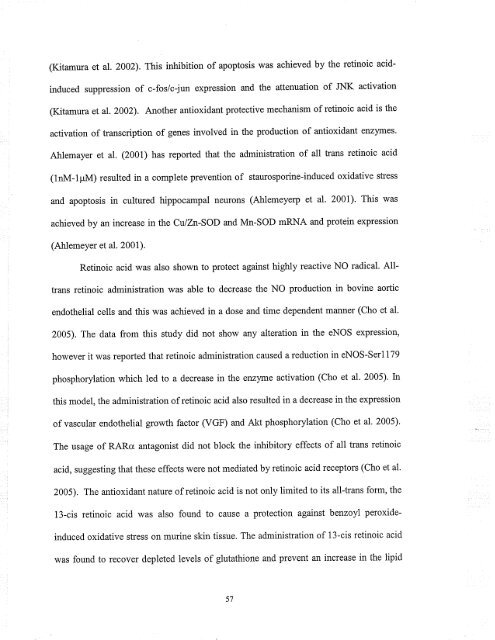il\VOLVEMENT OF RETII\OIC ACID II{ - MSpace at the University of ...
il\VOLVEMENT OF RETII\OIC ACID II{ - MSpace at the University of ...
il\VOLVEMENT OF RETII\OIC ACID II{ - MSpace at the University of ...
Create successful ePaper yourself
Turn your PDF publications into a flip-book with our unique Google optimized e-Paper software.
(Kitamura et al. 2002). This inhibition <strong>of</strong> apoptosis was achieved by <strong>the</strong> retinoic acidinduced<br />
suppression <strong>of</strong> c-fos/c-jun expression and <strong>the</strong> <strong>at</strong>tenu<strong>at</strong>ion <strong>of</strong> JNK activ<strong>at</strong>ion<br />
(Kitamura et al. 2002). Ano<strong>the</strong>r antioxidant protective mechanism <strong>of</strong> retinoic acid is <strong>the</strong><br />
activ<strong>at</strong>ion <strong>of</strong> transcription <strong>of</strong> genes involved in <strong>the</strong> production <strong>of</strong> antioxidant enzymes'<br />
Ahlemayer et al. (2001) has reported th<strong>at</strong> <strong>the</strong> administr<strong>at</strong>ion <strong>of</strong> all trans retinoic acid<br />
(1nM-1pM) resulted in a complete prevention <strong>of</strong> staurosporine-induced oxid<strong>at</strong>ive stress<br />
and apoptosis in cultured hippocampal neurons (Ahlemeyerp et al. 2001). This was<br />
achieved by an increase in <strong>the</strong> Cu/Zn-SOD and Mn-SOD mRNA and protein expression<br />
(Ahlemeyer et al. 2001).<br />
Retinoic acid was also shown to protect against highly reactive NO radical. Alltrans<br />
retinoic administr<strong>at</strong>ion was able to decrease <strong>the</strong> NO production in bovine aortic<br />
endo<strong>the</strong>lial cells and this was achieved in a dose and time dependent manner (Cho et al'<br />
2005). The d<strong>at</strong>a from this study did not show any alter<strong>at</strong>ion in <strong>the</strong> eNOS expression,<br />
however it was reported th<strong>at</strong> retinoic administr<strong>at</strong>ion caused a reduction in eNOS-Serl179<br />
phosphoryl<strong>at</strong>ion which led to a decrease in <strong>the</strong> enzqe activ<strong>at</strong>ion (Cho et al. 2005)' kt<br />
this model, <strong>the</strong> administr<strong>at</strong>ion <strong>of</strong> retinoic acid also resulted in a decrease in <strong>the</strong> expression<br />
<strong>of</strong> vascular endo<strong>the</strong>lial growth factor (VGF) and Akt phosphoryl<strong>at</strong>ion (Cho et al. 2005).<br />
The usage <strong>of</strong> RARcr antagonist did not block <strong>the</strong> inhibitory effects <strong>of</strong> all trans retinoic<br />
acid, suggesting th<strong>at</strong> <strong>the</strong>se effects were not medi<strong>at</strong>ed by retinoic acid receptors (Cho et al.<br />
2005). The antioxidant n<strong>at</strong>ure <strong>of</strong> retinoic acid is not only limited to its all-trans form, <strong>the</strong><br />
13-cis retinoic acid was also found to cause a protection against benzoyl peroxideinduced<br />
oxid<strong>at</strong>ive stress on murine skin tissue. The administr<strong>at</strong>ion <strong>of</strong> 13-cis retinoic acid<br />
was found to recover depleted levels <strong>of</strong> glut<strong>at</strong>hione and prevent an increase in <strong>the</strong> lipid<br />
57







![an unusual bacterial isolate from in partial fulf]lment for the ... - MSpace](https://img.yumpu.com/21942008/1/190x245/an-unusual-bacterial-isolate-from-in-partial-fulflment-for-the-mspace.jpg?quality=85)





![in partial fulfil]ment of the - MSpace - University of Manitoba](https://img.yumpu.com/21941988/1/190x245/in-partial-fulfilment-of-the-mspace-university-of-manitoba.jpg?quality=85)


